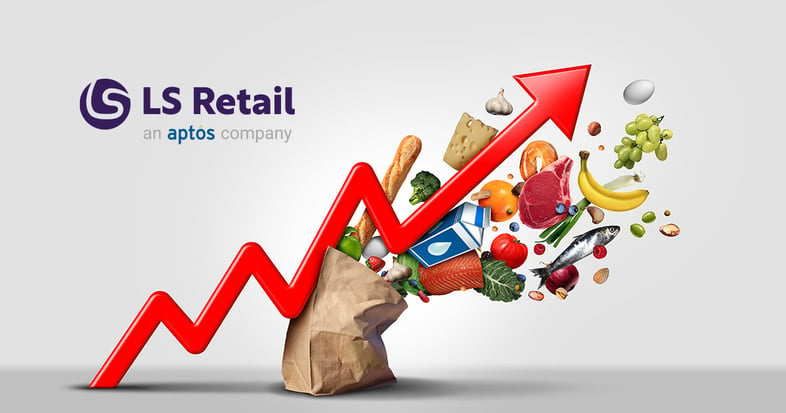
You don’t need us to tell you that soaring inflation is hitting consumers and businesses hard. Everyone is feeling the impact as prices on everything from food, energy bills and household goods escalate to record highs.
Industry bodies like the National Retail Federation (NRF) in the US, which monitors what’s happening across the sector, highlight some of the ways these types of events change consumer behavior, particularly in lower income households which are more vulnerable to the impact of inflation.
“When prices go up, consumers adjust how they shop depending on their household’s budget and needs,” NRF observed. “Lower-income shoppers are frequenting discount stores more, cutting back in other areas to afford necessities or buying less frequently to lower the number of shopping trips.”
While it’s hard to predict exactly what’s in store in the next few months, we do know that we’ve been through recessions before, and retail has continued to survive – and in some instances even thrive. Indeed, analyst McKinsey puts a more positive spin on the situation, saying that “retailers can catalyze these challenges into opportunities – if they make bold, deliberate decisions.” These decisions tend to be centered around digital transformation journeys, which help retailers gain the transparency, insights and capabilities they need to preserve margins and adapt fast to their customers’ and their own business needs.
With this in mind, here are five ways that you can take advantage of technology to make your business more resilient to inflation and the challenges coming our way:
1. Order in what will sell
It sounds obvious, but do you have the insights you need across your business to know exactly which types of products are most likely to sell? Even better, can you pinpoint moments throughout the year when it’s best to stock certain products and exactly how much? If you have the right planning and forecasting solution then these types of insights should be available at your fingertips.
To stand the best chance of weathering high inflation, retailers need full visibility of their stock in real time as well as powerful planning and forecasting software. These capabilities help them to order in the right products and quantities by knowing exactly what their customers are buying now and foresee what they will want in future. Intelligent analytics and forecasting tools allow you to interrogate data to identify buying trends and patterns and navigate supply chain disruptions so that you can accurately predict demand, ensure you can get your hands on the right amount of product, and adjust quickly when the situation changes.
“There is an immense benefit to doing predictive analysis, social sentiment analysis...and to be able to quickly leverage the full-scale assortment you have in store and online against what consumers are doing, in real time,” said one retailer in the survey by Nielsen and Coresight Research “The Secret to Fighting Inflation: Data-Driven Strategies for Retailers”.
2. Set realistic and appealing prices and discounts
Even if there’s a crisis, you don’t need to price every item cheaply, nor do you need to increase the number of promotions you run. Industry analyst dunnhumby goes as far as saying that running too many promotions can have a detrimental impact on perceptions of your brand. If you’re constantly discounting your products, then customers will be far less inclined to ever buy them at full price.
“Inflationary times offer a great opportunity to reset promotional strategies to save money and margin that can be reinvested elsewhere,” the analyst said.
This is the time, then, to get creative and rethink your approach to pricing and promotions using data-led insights. One company doing just that is UK supermarket Sainsbury’s, which is making substantial investments in new pricing pledges as it works to help ease the financial pressure consumers face – giving the company an opportunity to not only show that it cares, but to reevaluate its pricing strategy.
“We’re investing over £60 million to bring down our prices and you will find new Special Offers and Meal Deals to help you eat delicious, great food on a budget,” CEO Simon Roberts said in the summer in an email to customers. “We know there are some tough weeks and months ahead with energy bills going up and inflation hitting record levels.”
3. Get the most from your staff
You don’t have to be in this industry long to know that high staff turnover remains a big challenge for retailers. NRF puts the average staff turnover rate in retail at above 60%, which is substantially more than other industries – the average is around 19%. With all those people coming on and off your payroll, the incurred outlays quickly add up. Sourcing, hiring, onboarding and training drains store management time and resources and costs your business. What can you do, then, to attract the best staff, keep them productive and encourage them to stick around?
A modern POS system can certainly help. Not only does it enable you to plan and keep track of employee schedules, but it gives you a clear view of costs and performance too. Armed with this information, you can address short and over-staffed periods, identify top performing employees – and reward them – and provide targeted training and feedback to those who need it.
Gallup research shows that motivated, engaged staff are more likely to deliver a better customer experience and close more sales, and less likely to look elsewhere for a new job. Moving people from behind the counter away from monotonous, admin roles towards customer-focused engagement helps.
“The most innovative frontline retail employers are investing in technology to automate activities, freeing up time and energy for more meaningful roles in the store,” noted McKinsey. “Retail leaders should assess frontline employees’ most mundane activities and look for ways to simplify them, which can improve productivity and help make the job more attractive.”
4. Refine your omnichannel strategy
With both energy bills and petrol/diesel prices rising, retailers are bracing themselves for reduced foot traffic in their stores. A survey by Alvarez and Marsal’s Consumer and Retail Group (CRG) found that over half of consumers mostly or only shop when there is something they really need to buy, leading to fewer shopping trips and buying more items in bulk per transaction.
In these conditions, a seamless physical and digital presence becomes key to staying connected to your customers and encouraging them to do business with you. If they’re coming into your store fewer times or shopping less online, you need to make those experiences count. McKinsey offers an example of what this joined up shopping experience could look like: “Our app will help you with wayfinding, give you inventory visibility in the store, and allow you to access all of our omnichannel opportunities to place an order and pick it up. We’ll allow you to stand in the aisle and do research on a product by scanning a QR code.”
Retailers that use a unified commerce platform as their retail software are best equipped to deliver these types of omnichannel capabilities. A unified platform allows you to manage all channels and departments within a single environment so that you can see exactly what is happening across your business. It also allows your customers to pick and choose the shopping channels they prefer, with no disconnect in between.
5. Better understand your customers
Throughout hard times, it’s important to make sure your customers feel valued. This is where personalization becomes key. If you’re able to recognize your individual customers and their specific needs at every touchpoint across your business, then chances are they’ll stay loyal to your brand – and spend more with you. A report by Boston Consulting Group found that when the shopping experience was highly personalized, customers were 110% more likely to add extra items to their baskets and 40% more likely to spend more than they had planned.
So how do you deliver that personalized experience? That’s, again, where a unified commerce platform comes in. It connects all the data points across your business and channels so that you can identify who your customers are, whether they are shopping in store, online, on your mobile app, or in person, and connect all the data points so they form a complete picture.
“Having a deep understanding of your customer is critical during an inflationary environment, especially as customers continue to shift to online channels,” advised a Nielsen report. “With omnichannel customer-level analytics, retailers can have a more holistic view of their customers.”
At LS Retail, we are here to help. Our all-in-one POS and ERP software for the retail industry can you help you keep your business on track as you navigate all the challenges and opportunities that come your way in the coming months and years. Contact us to find out more.

